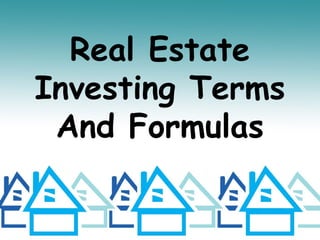Randon Morris | Real Estate Investing Terms And Formulas
- 1. Real Estate Investing Terms And Formulas
- 2. About According to Randon Morris Understanding the real estate investing terms and formulas is extremely helpful for brokers, agents and investors who want to service or acquire real estate investment properties. This is not always the case, though. During my experience as an investment real estate specialist I often encountered far too many that had no idea, and it showed both in their performance and success rate.
- 3. Gross Scheduled Income The annual rental income a property would generate if 100% of all space were rented and all rents collected. GSI does not regard vacancy or credit losses.
- 4. Gross Operating Income This is gross scheduled income less vacancy and credit loss, plus income derived from other sources such as coin-operated laundry facilities. Gross Scheduled Income - Vacancy and Credit Loss + Other Income= Gross Operating Income
- 5. Operating Expenses These include those costs associated with keeping a property operational and in service such as property taxes, insurance, utilities, and routine maintenance.
- 6. Net Operating Income NOI is one of the most important calculations to any real estate investment because it represents the income stream that subsequently determines the property's market value that is, the price a real estate investor is willing to pay for that income stream.
- 7. Cash Flow Before Tax This is the number of dollars a property generates in a given year after all cash outflows are subtracted from cash inflows but in turn still subject to the real estate investor's income tax liability.
- 8. Gross Rent Multiplier A simple method used by analysts to determine a rental income property's market value based upon its gross scheduled income.
- 9. Break Even Ratio A ratio some lenders calculate to gauge the proportion between the money going out to the money coming so they can estimate how vulnerable a property is to defaulting on its debt if rental income declines.
- 10. Loan To Value Loan Amount Ă· Lesser of Appraised Value or Selling Price = Loan to Value












